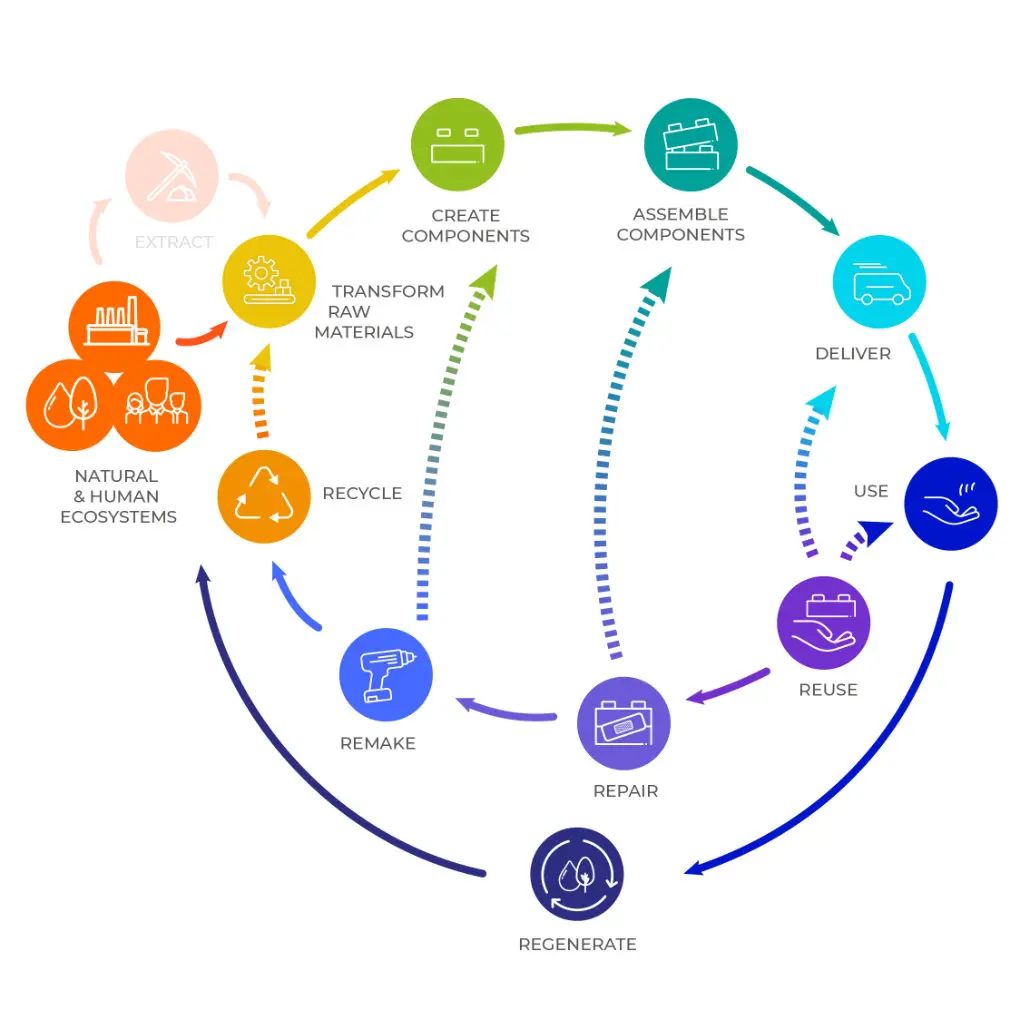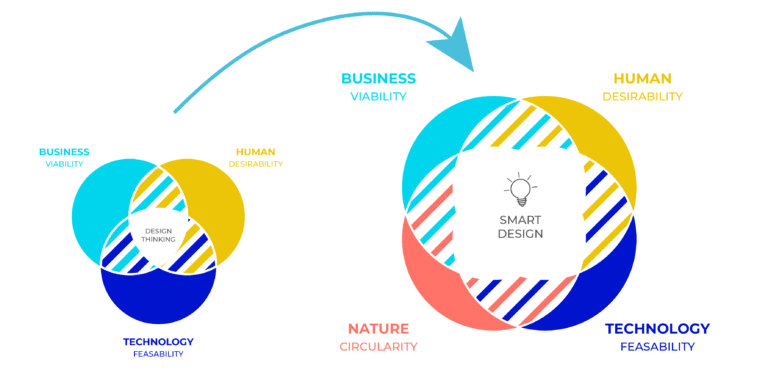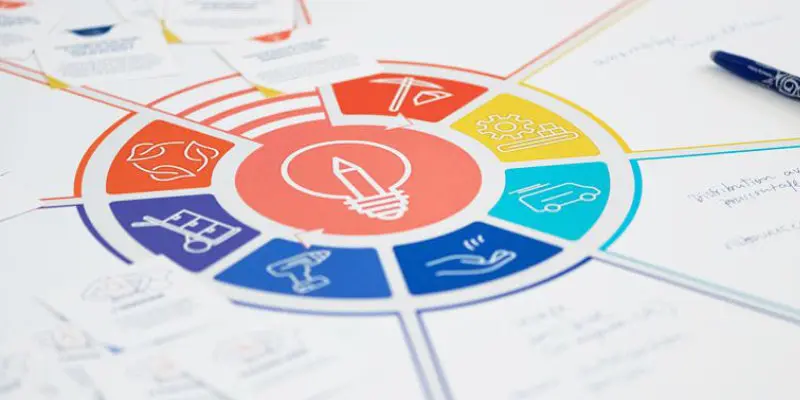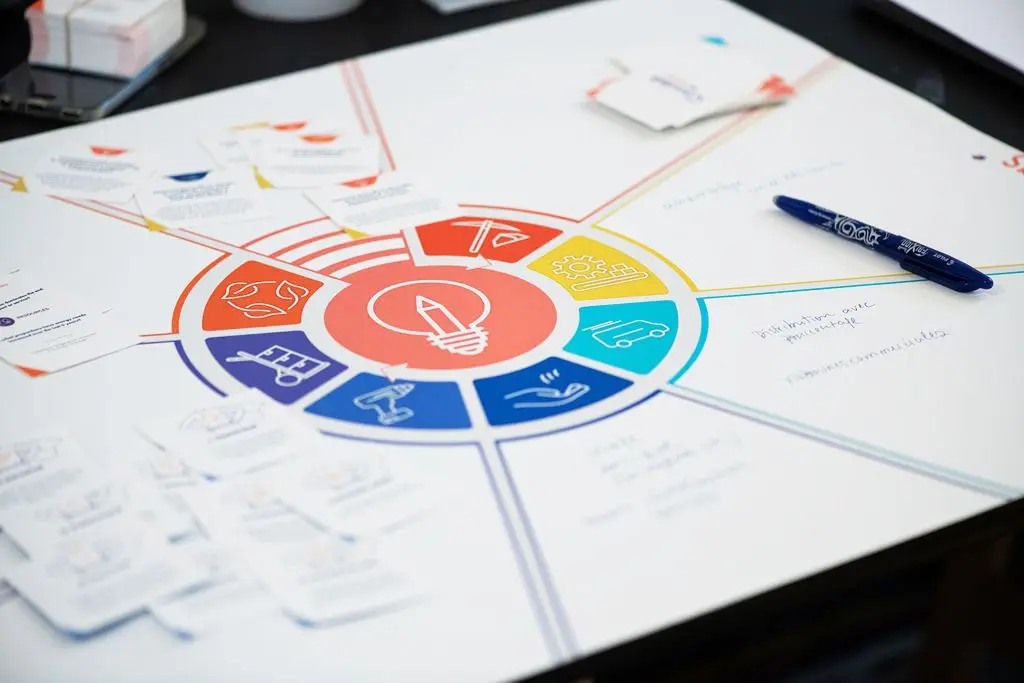Business Model Canvas Template
Circular Economy business models
Adapting an organization to long-term environmental, social and economic challenges is essential for any business.
Products and services eco-design strategies, waste management, renewable energy transition only scratch the surface of the problem.
Change must be profound and transform the business model of an organization towards Circular Economy principles.
Circular Economy: opportunities for environmental, economic and social performance
The problem with the linear economy
Our current linear economy extracts and processes finite raw materials to create products with short lifespans, most of which quickly become waste. This take-make-dispose model is unsustainable and directly contributes to biodiversity loss, resource scarcity, pollution, and climate change.
Global studies indicate that by 2060, natural resource consumption will double, while household and industrial waste production is expected to increase by 70%. This trajectory is neither environmentally nor economically sustainable.
At the same time, resources are becoming harder to extract, leading to rising costs, volatile prices, and unstable supply chains. Meanwhile, waste management systems remain inefficient—in Europe, for example, less than 30% of plastic waste is recycled, and recovery efforts remain minimal.
Why businesses must shift to a Circular Economy
Many business leaders fear that transitioning to more sustainable production and consumption models could hurt their profitability. However, Circular Economy principles offer companies a way to increase efficiency, reduce costs, and generate long-term value, all while benefiting the environment and society.
The Circular Economy is not just about recycling or CSR policies that delay the problem.
Instead, it rethinks the entire economic model, focusing on:
- Minimizing resource waste and reducing environmental impact.
- Optimizing efficiency at every stage—production, consumption, and waste management.
- Designing products and business models for circularity from the outset.
For any organization, integrating Circular Economy principles from the design phase is essential to building a resilient and sustainable business model that optimizes material flows and long-term impacts across the entire value chain.
Circular Economy new business models
Optimize
Ask why and how we consume products and services. Use locally available resources and aim at zero extraction of virgin raw materials, an activity responsible for 50% of greenhouse gas emissions and 80% of biodiversity loss.
Mutualize
Promote local economy to improve the resilience of a territory and encourage cooperation to develop know-how and collective intelligence.
Value
Transform waste into resources or alternatively create new income streams by using already circulating materials and resources.
Regenerate
Create positive social, environmental, economic impacts and allow the natural world to thrive. Reconsider the role of economic activities taking into account the physical limits of natural ecosystems.

Towards new environmental, social and economic business models
The limits of traditional business models
A traditional business model defines how an organization creates, delivers, and captures value by aligning human, financial, and material resources. Based on this structure, companies shape their strategy and operations to maximize profitability.
However, in a linear economy, traditional business model frameworks—such as the Business Model Canvas—tend to prioritize financial gains while overlooking social and environmental impacts. This short-term economic focus often leads to resource depletion, waste generation, and increased regulatory risks.
How the Circular Economy transforms business strategy
Inspired by nature’s regenerative cycles, the Circular Economy shifts businesses away from the take-make-waste model toward resilient, long-term strategies.
By adopting a circular mindset, companies can:
- Integrate all stakeholders into their value creation process.
- Anticipate and comply with evolving regulations and ISO sustainability standards.
- Innovate and gain a competitive advantage by designing more sustainable, resource-efficient business models.
A circular business model extends beyond economic profitability by embedding a holistic approach that balances financial, social, and environmental dimensions. This model fosters systemic and shared value creation, ensuring long-term business resilience and sustainability.

The Circular Canvas: the template for a circular business model
With the Circular Canvas, companies around the world can build a circular, sustainable and regenerative business model thanks to Circular Economy, biomimicry and system thinking. Download the Circular Canvas model for free then fill in the boxes directly to summarize your business model and have an overview of all its impacts.
In 7 questions, you will have a synthetic vision of your organization to really change the model, identify all impacts and detect new opportunities to improve environmental, social and economic performance.
The Circular Canvas allows you to consider all the impacts of your organization to transform them. The tool enables you to design a virtuous, resilient approach to the production, consumption activities and to transform the waste streams, into sources of economic, social and environmental performance for your entire ecosystem.
What is the purpose of your organization?
What human resources are needed?
What natural, technological and energy resources do you need throughout the life cycle?
What are your value propositions?
What are your relations with the distribution and development markets?
How to reduce costs and generate new revenues?
What are your impacts on society and the environment?

Get trained to reduce your impact on the natural and social environment
Modern organizations face growing ecological and economic pressures, including supply chain disruptions, raw material price volatility, climate-related disasters, and rising energy consumption. Adapting to these challenges is essential for long-term resilience and sustainability.
The Circular Economy provides a transformative solution, enabling businesses to ensure their viability while actively regenerating ecosystems. This requires a fundamental shift in mindset, rethinking value creation at every stage of the product lifecycle—from design and production to use and end-of-life management.
To fully integrate Circular Economy principles, businesses must redesign products, services, and business models with a holistic perspective. By doing so, organizations can:
- Reduce environmental impact and resource consumption.
- Lower operational costs through efficiency and waste reduction.
- Unlock new revenue streams and forge strategic partnerships.
At Circulab, we help companies worldwide implement circular and resilient business strategies. These include:
- Upcycling and cradle-to-cradle approaches to extend product lifespans.
- Beyond recycling: transforming waste into valuable resources.
- Reducing food waste and eliminating single-use plastics.
- Deploying symbiotic economy models to optimize resource reuse.
- Collaborative production & consumption to reduce waste and energy use.
If you’re ready to reduce negative impacts and embrace circular innovation, explore our online training courses to:
✔ Master Circular Economy principles.
✔ Learn circular design strategies.
✔ Build a circular and resilient business model.
Activate Circular economy
Explore the circular principles to drive change.
develop a sustainable, circular and resilient business
Discover the key concepts of resilience and develop your own resilience
Master Circular Design
Master our tools and methodology to deploy the circular economy
Access tried and tested free business design tools
Having set your organization's new circular business model using the Circular Canvas and having developed your skills on Circular Economy, you can discover the other tools of the Circulab Toolbox to deepen your sustainable approach and minimize the environmental impact.
Created in 2014 and now available for free in 11 languages, Circulab's business design tools are used by many companies, communities, agencies, business schools... around the world.
These tools will help you create or transform your organization with a systemic approach. Intuitive and collaborative, learn to explore your ecosystem as a whole, map the impacts of your business model, identify your stakeholders to develop sustainable partnerships, carry out life cycle analyzes and the entire value chain. Finally, these essential tools will allow you to create sustainable and resilient projects, products or services that apply and contribute to the Circular Economy.
Discover the circular economy newsletter
Sign up for the Circulab newsletter and like over 10,000 regeneration pioneers, receive our monthly newsletter in your inbox. Discover inspiring projects, news, advice to reduce your environmental impact, optimize your consumption of resources and achieve the circular economy.






